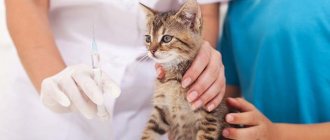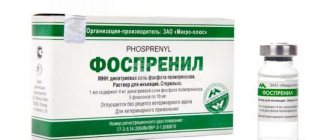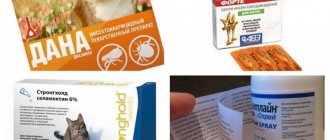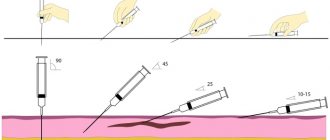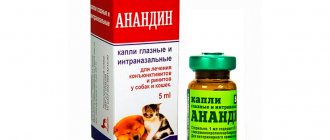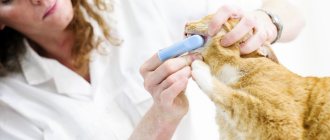If signs of dehydration are detected, the veterinarian will prescribe glucose for the cat. It is important to understand that a kitten and an adult especially need different dosages of the drug. Saline solution is injected into the pet subcutaneously at the withers or intravenously. Before injecting, the instructions for use should be carefully studied, since 5 percent glucose has a number of contraindications and often provokes negative reactions, especially if the dosage is not selected according to the weight of the sick cat.
Release form and effect of the drug
Glucose solution is a clear or slightly yellowish liquid contained in a glass vial or bottle. You can purchase injections for cats at any veterinary pharmacy. The main substance of the medicine is crystalline medical or hydrated glucose. The medication for cats also contains additional substances, such as:
- injection water;
- sodium chloride.
It is possible to purchase glucose in 5, 10, 25 and 40%, in which the percentage means the content of the active ingredient per 100 ml. Some veterinarians recommend feeding the solution by pouring the required amount of medicine into the cat's mouth using a syringe. But it is better to give an injection with glucose, since injections are more effective, especially if the pet is in serious condition. The medicine is used to replenish nutrients and fluids in the cat's body in case of dehydration.
One of the main effects of glucose is to improve metabolic processes in the cat’s body and stabilize heart function.
Operating principle
In veterinary medicine, isotonic and hypertonic glucose solutions are used.
For cats, one of these types may be used depending on the condition of the animal. The isotonic solution has a concentration of active substance of 5%. It is an easily digestible source of nutrition aimed at providing the animal’s body with the required energy. Glucose injection accelerates the removal of toxins, improves metabolism, and restores water balance.
https://www.youtube.com/watch?v=upload
A hypertonic solution contains 10, 25 and 40% of the main element. It plays an important role in improving the filtration properties of the liver and normalizes heart function. It has a beneficial effect on blood vessels and normalizes blood pressure. The drug helps to enhance the synthesis of hormones and enzymes in a weakened body, which increases its resistance to the disease.
Indications for use: in what cases does it help?
Administration of glucose intravenously or subcutaneously, as well as feeding the cat with glucose, is required when prescribed by a veterinarian. It is recommended to give the drug to an animal in order to maintain strength in the body during illness. Administering the solution intramuscularly or intravenously is indicated in the following cases:
- severe intoxication associated with food poisoning and chemicals;
- dehydration of the cat's body;
- internal bleeding;
- state of shock;
- infectious diseases;
- liver dysfunction;
- diseases of the digestive system.
Return to contents
Preparation for the procedure
The first and main point of preparation for the injection procedure should be a visit to the veterinarian with your pet. Most often, glucose is prescribed to rid the cat of the following diseases and abnormalities:
- Loss of fluid from the animal's body;
- The phenomenon of shock;
- Intoxication of the cat's body;
- Liver diseases;
- Diseases of the digestive system;
- Weakness and lethargy of the pet.
In this case, the injections may not contain an exclusive glucose solution, but a mixture with other drugs and antibiotics prescribed by the doctor.
Before you begin the injection procedure at home, you need to prepare all the necessary materials:
- Glucose solution in a closed container with a rubber stopper - 200 or 400 ml;
- Disposable syringe, preferably imported;
- Clean water for diluting the drug;
- Other drugs - when prescribed together with glucose.
Instructions for use
How to draw the solution into a syringe?
Before you introduce glucose into your cat’s body, you need to know how to properly prepare for the manipulation. The preparatory process includes the following procedure:
How to give an injection?
You can do the procedure at home, but first consult with a veterinarian about the dosage and clarify the nuances of administering the injection. It is better to carry out the manipulation together, since the cat may break free or scratch the owner. The procedure is performed in the following sequence:
After capturing the skin fold on the animal’s withers, the prepared drug can be administered.
- Fix the cat. If necessary, wrap the pet in a towel or rag.
- With your left hand, take the pet by the withers, pressing lightly. It is more convenient for left-handed people to perform the procedure with their right hand.
- Hold the animal with your elbow, while slightly pulling back the skin in the withers area.
- With your right hand, take a syringe with a glucose solution and pierce the skin with a needle parallel to the surface on which the cat is located. The needle does not need to be inserted more than a third under the skin.
- Loosen the grip on the pet's withers and slowly inject, gradually introducing glucose. It is necessary to check whether the medicine is spilled out if the needle is not inserted deep enough. If the cat's fur is dry, then the procedure was performed correctly.
Veterinarians recommend that owners behave calmly and confidently during manipulation, since anxiety is transmitted to the pet and it may begin to break free.
Contraindications and unwanted effects
It is possible to give glucose to a cat orally by dripping the solution into the pet's mouth. With any method of using the medicine, you must strictly adhere to the dosage prescribed by the veterinarian in order to avoid unpleasant consequences. The main contraindication to the use of glucose is the cat’s individual intolerance to active or auxiliary substances. And also, experts do not prescribe the solution to pets who have diabetes. Owners should be careful about giving glucose to cats during pregnancy, as this can negatively affect the development of the babies. It is contraindicated to use the medicine simultaneously with the following drugs:
- general anesthetics;
- sleeping pills;
- alkaloid solutions.
Owners should also take into account that the simultaneous use of glucose and analgesics or antifungal agents weakens the effect of the latter. If your cat drinks or administers the solution incorrectly, then after a while, adverse reactions may appear, such as:
Prohibitions to introduce
In what cases should patients not be prescribed 5% glucose? The instructions (for cats this remedy should only be recommended by an experienced veterinarian) speaks of such contraindications as:
- decompensated diabetes mellitus;
- hyperglycemia;
- decreased glucose tolerance (including during metabolic stress);
- hyperlactic acidemia.
Glucose is prescribed with caution for decompensated chronic heart failure, hyponatremia, chronic renal failure (with oliguria and anuria).
Is it possible to overdose?
If you follow the dose prescribed by the veterinarian and give it by mouth or give the injection intramuscularly correctly, then this phenomenon will not be observed. When owners begin to give their pet water or give injections on their own, the risks of overdose are high. If the solution is used excessively, the animal's blood and urine sugar levels increase. An incorrectly selected dose of glucose can lead to an imbalance of electrolytes and the accumulation of large amounts of fluid in the cat's body. If unpleasant symptoms continue for several days, then your pet should be taken to the veterinarian. In such cases, the medication is discontinued and insulin is prescribed or saline infusion is performed.
Glucose for cats is prescribed in the treatment of various diseases and intoxication syndrome. It helps to support the weakened body of the animal during the period of illness and until complete recovery. When using the drug, it is important to follow the instructions for use from the manufacturer, which are included in each package, in order to maximally protect your pet from unwanted reactions. Glucose is usually given by injection. The procedure can be performed either by a veterinarian or the cat's owner at home.
General characteristics
Glucose injection (Glucosi Solutio proinjectionibus) is a clear or pale yellow liquid that is placed in a glass vial or bottle. To ensure the tightness of the contents, a rubber stopper is used, which is reinforced with a metal cap. The bottle is accompanied by instructions from the manufacturer, which describe in detail its contents, method of use, expiration dates and GOSTs. The bottle with liquid is stored at above-zero temperatures up to 25C in a dark place, protected from excess moisture. Shelf life – 2 years.
The active ingredient of the drug is crystalline medical or hydrated glucose. Auxiliary elements are sodium chloride, water for injection.
They produce 5%, 10, 25 and 40% medicinal products, in which the active substance content is 5, 10, 25 and 40 g per 100 ml, respectively.
The market offers a wide variety of Russian and foreign-made drugs. The drug from the Voronezh pharmacological organization is quite popular. The developer produces an injection solution with different percentages of the active substance and varying volumes (from 10 to 500 ml). It can be used in the treatment of cats, dogs and other domestic animals, as well as large and small livestock.
Important! Before using the drug, consultation with a specialist is necessary. The description below is for informational purposes only and cannot be used for independent prescription and dosage determination.
Glucose Intramuscularly for Cats
INSTRUCTIONS for the use of Glucose 5.10, 25.40% injection solution for dehydration and intoxication of the animal body
1. GENERAL INFORMATION
1. Glucose 5, 10, 25, 40% solution for injection (Glucosi 5,10,25,40% solutio pro injectionibus).
2. Glucose 5, 10, 25, 40% - a medicinal product in the form of an injection solution containing 5, 10, 25 or 40 g of crystalline medical glucose or crystalline hydrated glucose per 100 cm3 as an active substance, respectively, and water as a solvent for injection
3. Glucose 5, 10, 25, 40% solution for injection is a clear, colorless or slightly yellowish liquid.
4. Glucose 5, 10, 25, 40% solution for injection is produced packaged in 10, 20, 50, 100, 200 cm* in sterile glass vials or bottles of 250, 400, 500 cm3 of appropriate capacity, sealed with rubber stoppers and reinforced aluminum caps.
Each bottle or bottle is labeled indicating: the manufacturing organization, its address and trademark, the purpose of the drug, the name and content of the active substance, method of use, batch number, date of manufacture, expiration date, volume in the bottle or bottle, storage conditions, inscriptions “Sterile”, “For animals”, state registration numbers, information on confirmation of conformity, designations of specifications and provide instructions for use.
Store the medicine in the closed packaging of the manufacturer in a dry place, protected from light, at a temperature from 0°C to 25°C.
Shelf life, subject to storage conditions, is 2 years from the date of manufacture. It is prohibited to use the medicine after the expiration date.
II. PHARMACOLOGICAL PROPERTIES
5. In veterinary medicine, isotonic (5%) and hypertonic (10, 25, 40%) glucose solutions are used for injection. An isotonic glucose solution is used to replenish the body with fluid and easily digestible, valuable nutritional material. In tissues, glucose breaks down and releases energy.
Hypertonic glucose solutions increase the osmotic pressure of the blood, improve metabolic processes, antitoxic liver function and heart function, dilate blood vessels, and increase diuresis. Glucose stimulates the synthesis of hormones and enzymes, increases the defenses of the animal's body.
6. After administration, the drug is quickly absorbed from the injection site and distributed in the organs and tissues of the animal.
We suggest you familiarize yourself with how a flea collar for cats works and whether it really helps, how much to wear and for what period, is it possible for a pregnant woman, is it possible to get poisoned, which one is better
According to the degree of impact on the body, Glucose 5, 10, 25, 40% solution for injection according to GOST 12.1.007-76 belongs to low-hazard substances (hazard class 4).
III. ORDER OF APPLICATION
7. Glucose 5,10,25,40% injection solution is used in animals with large losses of body fluid (bleeding, toxic dyspepsia), shock, intoxication, metritis, vaginitis, as well as for dissolving various medications.
Indications for use
Glucosi is used as an auxiliary drug, which is aimed at maintaining the strength of the animal’s body during illness. It can also be used to dilute other medications.
The most common reasons for use in cats are:
- severe intoxication (food poisoning, chemical poisoning, inflammatory diseases, etc.);
- replenishment of fluid loss;
- bleeding;
- shock phenomena;
- infectious diseases;
- liver dysfunction;
- pathologies and diseases of the digestive system.
Important! The dosage of glucose for cats and the duration of use should be strictly prescribed by the treating veterinarian. Do-it-yourself activities can harm your pet’s health!
Mode of application
The dose of glucose for cats is determined strictly individually. It is calculated depending on the weight of the animal, the concentration of the active substance, and the type of disease. The approximate dosage is:
- 5-50 ml for a 5 percent solution;
- 5-20 ml for 40 percent.
The drug is usually prescribed 2-4 times a day.
The drug can be administered subcutaneously or intravenously. A solution with a concentration of the active substance of 40% is administered only intravenously.
It is highly recommended not to skip the administration of the drug according to the schedule prescribed by the doctor. If this happens, then treatment is continued as soon as possible and in the same dosage as indicated by the veterinarian.
Performing an injection
You should check with your veterinarian about how to inject glucose into your cat. Subcutaneous injections are usually performed in the withers (adult animals) or in the upper part of the hind leg (kittens).
To carry out the procedure safely, you should adhere to the general rules for working with the drug:
- It is recommended to perform the procedure with gloves;
- Before and after the procedure, you should wash your hands thoroughly with soap;
- do not drink alcohol or smoke during the event;
- Do not take medications orally that are intended for injection.
Immediately before the injection, you should prepare everything necessary for the procedure so as not to be distracted during its implementation:
- Place a packaged syringe, a glucose solution of the required concentration, and additional medications if they were prescribed by a doctor on a hard surface.
- Open the syringe and draw the required amount of solution (mix the medications according to the prescription indicated by the doctor), release excess air from the syringe.
- Call the animal, put it on the table and secure it well (here you will need the help of someone close to you).
The injection itself is performed as follows:
- With your non-working hand (for right-handers - the left, for left-handers - the right) take the cat by the withers and slightly push the skin upward.
- Using your working hand (for right-handers - the right, for left-handers - the left), take the syringe and insert the needle into the withers no more than a third. The needle should be parallel to the surface on which the cat is located.
- Slightly loosen the grip on the skin and inject the medicine. An indicator of the correct execution of the manipulation is dry hair at the injection site. If the fur gets wet, it means the medicine has not entered the body and the procedure must be repeated.
- Smoothly pull out the needle, release the withers completely and massage a little.
The more confident and smooth the movements of the person giving the injection, the more painless the procedure will be for the cat.
How to give an injection to a cat
Before injecting a cat with glucose subcutaneously, it is necessary to calm the animal, relax it and prevent it from becoming nervous. After this, you should carry out the procedure following the instructions:
- Secure the cat. The animal can be positioned in a way that is convenient for the owner for the procedure.
- With your left hand (for left-handers - right) take the animal by the withers and lightly squeeze it.
- Holding the cat with your elbow, slightly pull back the skin of the withers.
- With your right hand (for left-handers - your left), take a syringe with medicine and insert its needle parallel to the surface on which the animal is standing. The needle should not be more than a third under the skin. All movements should be made as smooth and confident as possible.
- Loosen your grip on your pet's withers and slowly release the glucose. Check that the drug is accurately delivered subcutaneously: if the cat’s fur does not become wet, then everything has been done correctly. Otherwise, the procedure must be repeated.
After the injection, it is recommended to slightly stretch the pet’s withers so that the drug spreads faster in the body.
To carry out the procedure correctly and as painlessly as possible for the cat, you need to accurately select the place where the injection will be given. Thus, for adults and large animals, glucose is most often prescribed to be injected into the withers, and small kittens are allowed to receive an injection into the upper part of the hind leg. Thus, the pet will feel less discomfort.
The painfulness of the procedure for the animal may also depend on how many times and in what quantity glucose is administered. The less glucose is injected, and the fewer procedures are performed, the less pain the cat will feel.
Contraindications
The solution is not used in animals that have individual intolerance to the components of the drug or diabetes mellitus.
Despite the fact that no overdose symptoms have been recorded in animals, you should not exceed the dose of the drug indicated by your doctor.
The solution is a fairly inexpensive drug. Its price will depend on the volume of the bottle, the concentration of the active substance, and the financial policy of the manufacturer.
On average, the cost for a 100 ml bottle is 50 rubles.
Owner reviews
“The cat was diagnosed with acute gastroenteritis. They prescribed a course of certain medications and glucose. Basic medications were administered directly from the vet, and at home I injected my own glucose. The cat’s illness did not linger; she gradually began to eat and drink on her own, after which the medications were discontinued. The question arose when the solution for veterinary purposes ran out and I had to buy a regular (human) one. It turns out that it can also be injected into animals, but it is advisable to still use a veterinary one.”
“A kitten strayed to us and we decided to keep it. However, he turned out to be sick, did not eat, did not drink, was lethargic, vomited, and lay motionless. They took him to the veterinarian, where they took blood tests - it turned out to be a bacterial infection. An antibiotic and glucose injections were prescribed. Getting the kitten out turned out to be difficult, but we did it. Glucose helped very well to support the animal, since he could not eat anything and even vomited from water. Now everything is all right".
Recommended analogues
Saline solution has quite a few contraindications, so it can be used by kittens and cats of any age. But if, for some reason, the veterinarian does not recommend using a veterinary drug, then it is replaced with a drug with a similar effect. Since saline solution is used for various purposes, it has many analogues. For example, you can rinse a cat’s nasal passages with Aqualor. If subcutaneous administration of the product is indicated, then you can replace it with a “Xylate” solution or make a saline solution yourself using water and ordinary salt.
Glucose is an essential substance for humans and animals. It provides the body with energy and is also directly or indirectly involved in most metabolic reactions. In a healthy cat, the level of glucose obtained from food is regulated and maintained at a constant level.
During the acute period of illness, many animals suddenly lose their appetite, and their body begins to experience a shortage of the substance it needs. In such situations, veterinarians often recommend replenishing the lack of glucose with injections. How and in what cases should glucose preparations be administered subcutaneously to a cat? How to properly give an injection at home?
Reviews from veterinarians
“Glucosi solution is often used in veterinary medicine to treat various diseases (including liver diseases, urolithiasis, infectious lesions, etc.). This is an excellent remedy for restoring fluid loss and providing the animal with energy (especially if there is a loss of appetite). However, self-treatment even with such a seemingly harmless drug is prohibited. It is necessary to strictly follow the indications and dosage of the drug, otherwise irreparable harm can be caused to the animal.”
“I would like to note that if glucose injections can be done freely at home (the doctor can show the manipulation the first time, and then the owner can handle it himself), then intravenous administration should occur under the supervision of a specialist. You can take your pet to a veterinary clinic or call a doctor at home. Without possessing certain skills, it is difficult to administer the drug correctly, which will negatively affect the treatment process.”
Is it possible to inject a cat with glucose subcutaneously?
Go to the vet. It will be more reliable.
Glucose solutions of 5% and 40% are produced packaged in 100 ml glass bottles from... Manufacturing organization NPP Agropharm CJSC, Russia, 394087... Relatively inexpensive. Desperate to cure the cat, they went through...
How do you love your cat, though?
You are unlikely to help him at home, at the vet. I need a clinic. You won't cure it with glucose alone. Moreover, it must be dripped subcutaneously and cannot be injected as a stream.
Three days is not a long time for animals.
It is possible and in this case even necessary. Prick at the withers. This will protect you from dehydration and maintain strength. But it's best to take it to the vet. Why are you delaying, why are you waiting to take him to the hospital, it won’t go away on its own. Glucose is specifically for injection, and not just any kind.


